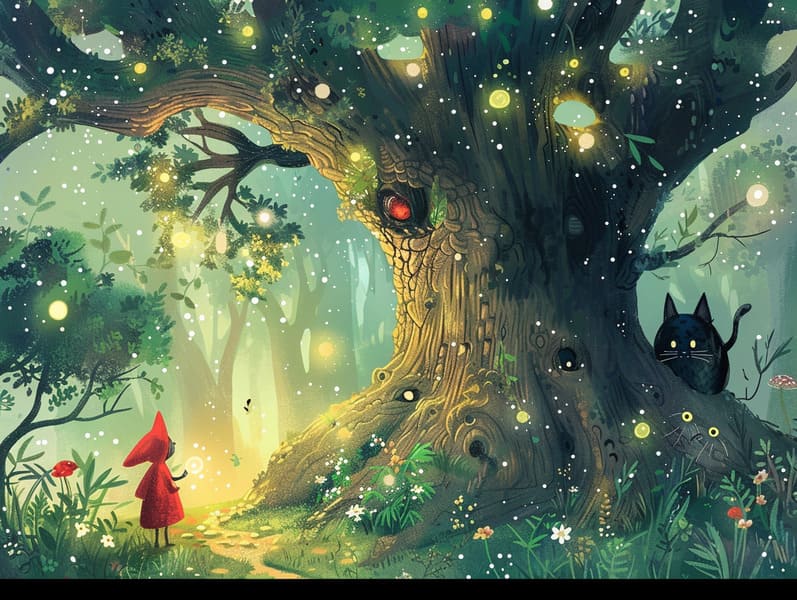
Old fairy tales have historical significance. These stories have been whispered from one generation to the next millennia before they were ever documented. They originated from a variety of societies, including Indigenous traditions. They were initially shared among adults, often carrying themes and messages pertaining to the societal norms and beliefs of the time.
Jacob and Wilhelm Grimm, Jacob and Wilhelm (the Grimm brothers), were among the first to collect many of these beloved fairy tales. Their volume, "Grimm's Fairy Stories," included stories like "Ashenputtel," "The Bread Crumb Trail," and "Schneewittchen," which have since become essentials in the world of classic fairy tales. Similarly, Hans Andersen's whimsical narratives, such as "The Sea Maid," and "The Little Duckling," have touched hearts worldwide, cementing their place in the pantheon of iconic fairy tales.
Despite their ancient origins, classic fairy tales remain as meaningful as ever, especially as bedtime stories for kids. These fantastical tales are now available in different formats, including vibrantly illustrated books, captivating animations, and web-based fairy tales.
Their unwavering allure can be ascribed to several whimsical characteristics:
Significant Morals: Old fairy tales often share important moral lessons. Fairy tales like "The Story of the Boy Who Cried Wolf" teach the significance of integrity, while "The Tale of the Tortoise and the Hare" emphasize the virtues of determination and modesty. These tales offer young ones clear distinctions between good and bad, molding their moral compass in a gentle yet profound way.
Warmth and Understanding: Old fairy tales frequently depict individuals facing trials and tribulations, inciting young listeners to understand with their struggles and boost their triumphs. For instance, "Beauty's Beast" highlights the merit of looking deeper to perceive the true being of a being, promoting insight and understanding.
Cultural Perception: Many old fairy tales are deeply ingrained in the cultural contexts from which they arose. Understanding these narratives can provide captivating looks into different backgrounds, building a sense of global respect and comprehension.
Imagination and Innovation: The mythical elements in timeless fairy tales—magical beings—motivate children’s fantasy worlds. These narratives guide readers to enchanted realms, unleashing innovative ideas and a sense of curiosity that lasts a lifetime.
Classic fairy tales are not only charming but also informative. They serve as bewitching tools in developing various mind and heart abilities in children. When traditional fairy tales are voiced, they boost communication skills by teaching new words and elaborate sentence structures. This practice also nurtures auditory perception and mindfulness, as children listen intently, enthusiastic to see what happens next.
Furthermore, debating the themes and characters of old fairy tales can promote reasoning skills and cognitive skills. Young readers are shown to pinpoint patterns, expect results, and know cause and effect. These contemplations also benefit children reveal their thoughts and feelings, boosting their emotional intelligence.
In today’s electronic age, the accessibility of digital storybooks has made these stories more acquirable than ever. Online resources and apps make available broad selections of popular fairy tales that can be perused or heard anytime, anywhere. Fairy tales read out loud are particularly common, offering an charming way for kids to savor these charming stories. Audio stories and narrated videos transport characters and settings to life, often supported by fantastical harmonies and instrumentals that enhance the narrative journey.
The unending appeal of classic fairy tales lies in their ability to shift to current eras while staying true to their core messages. Contemporary modernizations of these stories often highlight more different figures and modern settings, making them understandable to today’s audience. However, the main ideas of heroism, generosity, and impartiality remain unchanged, continuing to touch kids of all ages.
Timeless fairy tales also offer a sense of comfort and knownness. They deliver a ordered narrative with a obvious beginning, middle, and end, often ending with the settlement of conflicts and the triumph of honesty over deceit. This certainty can be calming for young readers, imparting a sense of sturdiness in an inconstant world.
Timeless fairy tales continue to enchant and educate new generations, maintaining their attraction and pertinence in modern society. As kids' bedtime tales, they showcase a perfect blend of fascination and comprehension, aiding moral values, empathy, and creativity. The abundance of free fairy tales online and the likability of fairy tales voiced guarantee that these traditional narratives remain reachable to new generations.
By guarding and spreading these narratives, we continue to acknowledge the rich tapestry of mythology and cultural heritage. Whether you are seeing a richly illustrated book, perusing a cyber collection, or listening on an audio story, the charm of traditional fairy tales is always within reach. These fairy tales highlight of the unwavering presence of fairy tales and its ability to bind us across epochs and places.
No matter if you are seeing a richly illustrated book, seeing a cyber library, or playing an narrated book, the grandeur of popular fairy tales is always within awesome site reach.
These fairy tales show us of the unceasing nature of storytelling and its ability to link us across time and space, forming a connection that captivates and teaches alike.